#Raw mango dal fry
Text
Raw Mango Dal Fry (North Indian Style)
Raw Mango Dal Fry (North Indian Style)
Raw Mango Dal Fry is a delicious and tangy Indian lentil curry made with raw mangoes and spices. It’s a popular dish, especially during the summer season. When raw mangoes are abundant. The tartness of the raw mangoes adds a unique flavour to the dal, making it both refreshing and satisfying.
For more recipes from this blog you might like please…

View On WordPress
#Dal recipe#Dal recipe with green mango#Easy Recipes#Indian mango dal#Indian mango recipes#Kairi dal fry (Kairi is the Hindi term for raw mango)#Kairi dal fry (using the Hindi term for raw mango)#Mango dal fry#Mango dal recipe#Mango lentil curry#Mango lentil stew#Raw mango dal#Raw mango dal fry#Regional Indian Cuisine#Spicy mango dal curry#Spicy mango lentil stew#spicy veg recipes#Summer dal dishes#Summer dal recipe#Tangy dal recipe#Tangy mango lentil curry#Toor dal with mango#Toor dal with raw mango
0 notes
Text
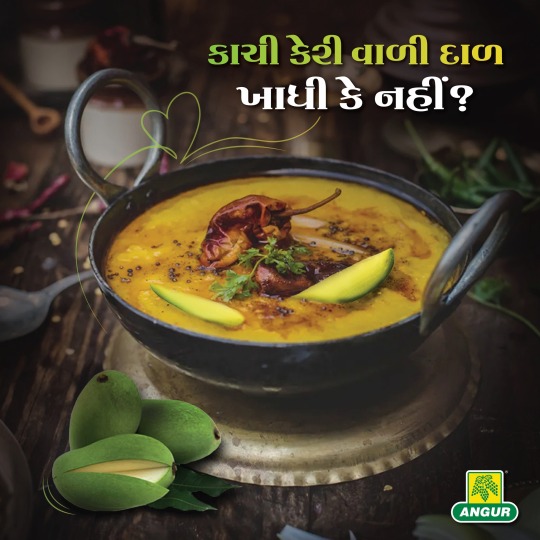
Angur Toor Dal | Buy Online Angur Pulses
Why settle for boring, bland food when you can enjoy the delicious Raw Mango Dal Fry? This dish not only satisfies your taste buds but also provides a host of health benefits.
Buy Angur Toor Dal from the nearest kirana store.
#toor dal#angur toor dal#buy online toor dal#angur pulses#angur products#healthy food#tasty food#buy angur toor dal#angur pulses products#pulses#follow back#angur#follow
3 notes
·
View notes
Text
What does Krishna eat?
Krishna can eat the whole universe but fearing that some would criticize Him for being a glutton, He eats only a little of each food preparation that is offered to Him. Let’s see the detailed preparations that Krishna eats.
Many different types of excellent preparations are made using pumpkin, potato, kachu, and radish. One preparation uses mustard, ginger, and bitter leaves fried in mustard oil.
Small pieces of eggplant are also cooked with Mung dal patties, ground ginger, and pieces of coconut fried in mustard oil, to produce a tasty dish.
Small pieces of eggplant, yam, kakarola, banana flower, mana-kachu, patalo, and white pumpkin are dried, skewered, and deep-fried to make another dish.
Eggplant, green banana, coconut, chick peas and mung dal patties are mixed and pepper and sugar are added to produce two different dishes, one spicy and the other sweet.
A soup with excellent aroma is also prepared from beans mixed with coconut and prthu root, mixed with lots of ghee, hing, ginger, and raw sugar.
Finely ground coconut is mixed with sugar syrup, milk, and mung dal to make one another dish, and cardamon, clove, pepper, hing, and ginger are mixed to make mung soup- a second soup.
Another soup (third soup) is also made using skinned mung beans, boiled and mixed with milk, and spiced with cardamon, clove, pepper, hing, and sugar.
A fourth soup is also prepared from husked beans and chopped radish with lots of ghee, hing, and pepper.
Another preparation involves selecting the hearts of the best banana and chopping the banana flowers finely, discarding the fibers. It is then cooked with milk, hing, and pepper. This dish is called Marica.
Chopping up arbi and radish finely and skinning unripe jackfruit, another dish is prepared. It is then cooked with dal patties, hing, pepper, and other spices.
Bottle gourd is sliced in long fine strips and is boiled in water and milk, while continuing stirring, till it thickens. Adding sugar, pepper, cumin, hing, and other spices, another delicious dish is prepared.
Taking ripe pumpkin and chopping it finely, frying it in mustard oil, spicing it with ginger, hing, and anise, and mixing it with thickened buttermilk, a sour yogurt dish is also prepared.
In another preparation, radish and puru are cut in circles and cooked in yogurt and black sugar. Mixed with tamarind, another sour preparation is made.
Chickpea flour, yogurt, turmeric, and citron juice are mixed and formed into soft, attractive balls known as kanjika-bati.
Green mango mixed with mustard seeds, and fried in ghee, produces another sweet preparation. Ripe mango mixed with water, sugar, and milk produces a sweet and sour preparation.
Roasted sesame mixed with dry mango produces another sour preparation and toasted sesame with cinnamon makes another dish. Green and ripe mangoes are mixed with sweetened milk and hing to produce more sour dishes.
Cakes are prepared from coconut, rice, roasted sesame, and milk. Warm filtered water is poured over these and are left covered. Then, condensed milk is added. This preparation is called Chitra.
Cream mixed with pepper, camphor, and raw sugar is formed into huge balls known as sara-dugdha-kupi. Using mund-dhal and other ingredients, various pistakas are made.
Sweets such as jilavika, mathahari, puru, pupa, gaja, nada and saraswati are also made. Also are made kharcura, dadimaka, sarkara- pala-mukta, and ladduka.
Laddus are made from condensed and curdled milk. Manohara, hamsakeli, sobharika, daibada, ghola-bada, attakeli, and veni (wheat noodles cooked in milk) are some varieties of Laddus.
Chandrakanti, lalita, amrtapuli, and other sweets are also made. Yogurt, butter, buttermilk, milk, sarabhaji, srikhanda, and other edibles, and many excellent drinks are also made.
All these food preparations are served with rich aromatic white rice, soaked in ghee. All these are served with ghee, slices of lemon, pickles, ginger, mango, mustard sauce, and other such condiments. Huge jugs of water are also served which is scented with camphor.
In this way, innumerable preparations with enticing aromas are prepared, arranged, and served beautifully on the dining table, placing them on jeweled and golden trays for the pleasure of Krishna. Mother Yashoda and Rohini arranges to serve food in proper order and Krishna eats them in that order. Whatever Krishna begins tasting, He is unable to resist eating it. And though He wants to eat all of the preparation, and has the ability to do so, out of fear of onlookers and criticism of being a glutton, Krishna tastes only a little of each preparation.
Lord Krishna begins by eating payasa (sweet milk rice). By eating this payasa, Krishna silently says in His mind ‘’Delicious, Delicious!’’. There are many preparations in huge quantities and Krishna wants to eat them all. He thus takes some amount of all the preparations and thus starts eating the main course, beginning with spinach.
While eating, Krishna makes His companion laugh with His sweet humorous words, saying ‘’Eat, eat, don't leave anything’’, thus giving deep pleasure to each one of His associates.
Taking a little rice, Krishna eats each vegetable prepared with it. But His greed for each item cannot be satisfied. While praising each of His favorite cakes and milk sweets, He eats them all and pretends to be satisfied.
Though Mother Yashoda and Rohini say, ‘’Eat more, Eat more’’, He gives a show of being full, though internally He is never satisfied. Finally, washing His lotus feet, hands, and mouth, and then wiping them, Krishna takes tambula and spices and lays down on a soft bed for some time.
I hope, you got a basic idea of what Krishna eats. Finally, special credit for all this cooking goes to Srimati Radharani and Her close associates.
May one who reads this with attentive faith and devotion develop pure love for Krishna. These confidential descriptions are mentioned by the confidential associate of Lord Krishna- Sri Kavi Karnapura, in his Sanskrit Kavya ‘Krishahnika Kaumudi'. The english translation is offered by H.H. Bhanu Swami. I have thus shared these details, as mentioned by our acharyas.
4 notes
·
View notes
Text
Delicious Sambar Masala Recipe with Suhana Sambar Masala
Do you know about the origins of Sambar? This lentil-based stew prepared with vegetables, tamarind, and spices was introduced in Tamil Nadu during the Marathi reign in Tanjore and can be found throughout South India. Having a tangy and savoury taste, sambar goes well with rice, dosa, idli, upma, vada, etc. It’s rich in protein, and you can have it for breakfast, lunch, and dinner, making you feel satiated. You can make an authentic sambar with the right spices at home. If you can’t, here’s an easy way to make sambar – through Suhana Masala. Here’s how you can make traditional South Indian sambar at home easily!
How do you make a sambar using the traditional South Indian method?
List of the ingredients needed for making authentic sambar
Here’s what you need to make sambar:
Toor dal – 1 cup
Vegetables of your choice – shallots, drumstick, potato, capsicum, broad beans, ladies finger, cut into broad pieces (you can add any one of these with shallots to make sambar)
Tamarind pulp – 1 cup (soak a lemon-sized tamarind in hot water and extract the pulp)
Suhana sambar masala – 2 tablespoons
Oil, mustard seeds, hing, dry red chillies, and curry leaves for tempering.
Water and salt as required
Jaggery – 1 tablespoon (optional)
Coriander leaves (optional)
Step-by-step sambar recipe with Suhana sambar masala
Add toor dal and vegetables of your choice to a pressure cooker and cook for four to five whistles.
Meanwhile, peel the shallots. In a kadhai, add oil and fry the shallots. Once cooked, add the tamarind pulp and let it cook for some time until the shallots become soft. Ensure to cook this on simmer mode. If you do this on high flame, the tamarind pulp may become thick in no time, and it might affect the taste of your sambar.
Once your toor dal and vegetables are cooked, add the mashed lentils and vegetables to the tamarind pulp and shallots mix, with Suhana sambar powder and jaggery, with salt and let it boil for 10 minutes.
You can also cook the vegetables directly in the tamarind pulp, but this may take a while. So, if you are on a time crunch, just use a pressure cooker!
Add water if your sambar is thick. If not, add oil and mustard seeds in a small frying pan. After they splutter, add hing, curry leaves and dry red chilly. Add this to your sambar and turn the stove off.
Authentic South Indian sambar is ready with a Suhana mix in no time!
Serving Suggestions
Serve it hot with rice, idli, or dosa. If eaten with rice, adding ghee or sesame oil may enhance the sambar taste! You can garnish with coriander leaves before serving. However, it’s entirely your choice, as the taste does not alter with coriander, but this will give off a wafting aroma!
Health benefits of spices and herbs used in Suhana sambar masala
Suhana sambar masala has no added preservatives or MSG, making it completely safe to consume. Turmeric in the masala acts against inflammation in the body and reduces infections and allergic reactions. Cumin and fenugreek aid in digestion, regulate blood sugar levels and promote healthy blood circulation. You can add sambar to your daily diet, and it’s highly nutritional. Protein-packed lentils and vegetables like shallots will help your body cool down during summer!
Here’s to making delicious sambar at home with Suhana! You can get this from our website.
FAQs
Can I use other types of lentils instead of toor dal?
You can also add moong dal to sambar, but this may alter the taste of sambar a bit. Or you can use both, depending on your choice!
Is it necessary to use tamarind pulp, or can I substitute it with something else?
Tamarind pulp is necessary to make sambar. If you don’t use tamarind, add local tomatoes instead of apple tomatoes for a tangy flavour.
What vegetables can I add to the sambar?
To your sambar, add potato, drumstick, raw mango, broad beans, carrot, capsicum, radish, pumpkin (white and red), and shallots.
0 notes
Text
Healthy recipes you can prepare from Thooyamalli Rice | Five Element Food from Heaven | Best Online Organic Store
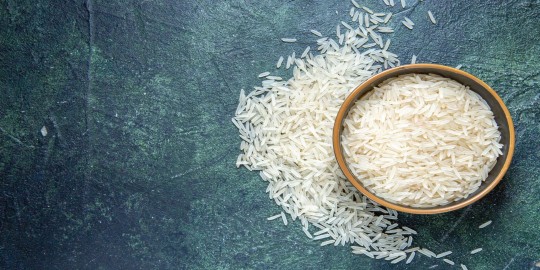
The name of the traditional rice variety from Tamil Nadu known as "Thooyamalli" refers to a jasmine flower that has just bloomed. Rice with a pearly appearance. It is pleasant and nutritious, and it is pest-resistant, and doesn't require pesticides. It's time we should take a U-turn and return to our old native rice varieties.
Try out our recipes to lead a healthier lifestyle by restoring the use of our nutrient-rich local rice type
Thooyamalli Manga Sadham
Ingredients
Rice-1 cup
Water-4 cups
Raw Mango-1 (Medium sized)
Onion-1 cup(chopped)
Groundnut-2 tbsp.
Oil-To cook
Salt-To taste
Green Chilly-2
Mustard seeds-1/4 tsps.
Split Urad Dal-1/4 tsps.
Gram Dal-1/2 tsps.
Curry leaves
Procedure
Wash and soak the rice for an hour. In an open pot add four cups of water and heat it. In the meantime, rinse the rice well and drain the water. When the water boils add the rice. Add a few drops of oil as we are making raw mango rice. Cook on low flame for 20 minutes. Use a holed plate and drain the excess water. The thooyamalli rice is cooked and ready. Wash and peel the raw mango. Grate it using a grater and set it aside. Dry roast groundnuts and peel the skin after cooling. Add oil to a pan and temper with mustard seeds, urad dhal, gram dhal, and curry leaves. When tempering is done add chopped green chilly and shallots and saute well. When shallots turn golden brown add the grated mango and saute till the raw smell vanishes (The mixture will turn non-sticky). Cool it and add the groundnuts, and salt and mix it with rice.
Thooyamalli Jeera rice
Ingredients
1 bay leaf
2-inch cinnamon piece
4 cloves
4 green cardamoms
2 teaspoon jeera
Procedure
Heat 2 tablespoon ghee or oil in a pot or cooker, add 1 bay leaf, 2 inches of the cinnamon piece, 4 cloves, 4 green cardamoms, 2 teaspoons of jeera, thinly sliced onion, and one deseeded green chilli. Saute it on a medium to low flame until the jeera gets roasted well and begins to smell good. Add drained thooyamalli rice and fry it for 2 to 3 mins on high flame. Add water, if making in a pot pour 3 cups of water and if in a pressure cooker pour 2½ cups of water and add salt according to your taste. Cover it and pressure cook it on high flame for 1 whistle. If cooking in a pot, cover and cook it on low heat until the water gets absorbed and the jeera rice is fully cooked.
Serve it with your favorite curry or dal.
Rice is healthy. We know this. So is eating a healthy, well-balanced diet.
Now you could enjoy some popular dishes people eat, rice, and stay on track with the latest in nutrition with the help of Five Element “Food from Heaven”.
#five element food from heaven#five element#organic food#healthyfood#organically grown#healthy life choices#thooyamalli rice#traditional rice variety#recipes#thooyamalli rice recipe#jeera rice recipe#manga sadham recipe#mango rice recipe
0 notes
Photo

Reposted from @hungry_medico - Simple lunch plate.. ❤️ ❤️ RICE.. ❤️ ❤️ DAL FRY.. ❤️ ❤️ RAW MANGO CHUTNEY ❤️ This dish has my child hood fvt.. It's both sweety and soury. And my mom made it spicy too.. POTALA CURUMA /PARBAL KI SABJI/GOURD STIR FRY ❤️ ❤️ ROSTATE PAMPD.. ❤️ ❤️ . . . . #gourd #mango #food #foodpornshare#foodforfoodies #foodgraphy #foodism#eatfamous #mumbaifoodie #delhieats#indianfoodblogger #foodspotting#indianfoodbloggers #odiafood #buzzfeedfood#nomnom #goodeats #eeeeeats #foodstagram#mumbaifoodtrail #foodiesofbhubaneswar#instayum #f52grams #delhi_igers #igfood#foodlove #feedfeed #walkwithindia #instadaily#foodstagram #foodbeast https://www.instagram.com/p/BwEXRvGncad/?utm_source=ig_tumblr_share&igshid=lr4j55l157ic
#gourd#mango#food#foodpornshare#foodforfoodies#foodgraphy#foodism#eatfamous#mumbaifoodie#delhieats#indianfoodblogger#foodspotting#indianfoodbloggers#odiafood#buzzfeedfood#nomnom#goodeats#eeeeeats#foodstagram#mumbaifoodtrail#foodiesofbhubaneswar#instayum#f52grams#delhi_igers#igfood#foodlove#feedfeed#walkwithindia#instadaily#foodbeast
1 note
·
View note
Text
How To Cure Endometriosis With Ayurveda: A Doctor's Guide
Understanding Endometriosis
Endometriosis is a gynecological condition that affects 1 out of every 10 women of reproductive age. It is defined as the presence of functional endometrium (the internal cellular lining of the uterus), insights other than the uterus. It is of 2 types- externa and interna.

Externa refers to endometriosis of any part of the body except the myometrium (muscular wall of the uterus).
In interna, endometriosis is found in the myometrium (muscular wall of the uterus).
Although evidence has been presented that subtle endometriotic lesions are a normal physiological condition occurring intermittently in all women. But normally these extra growths are destroyed by our immune response, whereas in endometriosis this mechanism fails. Endometriosis also makes conception harder for some women.
Contributing factors or possible causes:
1. Retrograde menstruation- instead of flowing downwards, the menstrual blood travels upwards and spills in the peritoneal cavity.
2. The dominance of the hormone estrogen- leads to the growth of the endometrial cells.
3. Altered immune response- doesn’t allow auto-destruction of these unnatural growths.
4. Genetic influence
Understanding The Ayurvedic Perspective
According to Ayurvedic physiology, Arava (the reproductive apparatus along with the menstrual blood and the ovum) is formed from the Rasa Dhatu (the first tissue formed after digestion and metabolism). When the food habits are faulty like an excessive indulgence is heavy, fried, oily, or too dry food, incompatible foods like fruits with milk, excessive junk food, non-vegetarian dominant or dairy dominant food, overeating, etc, the metabolism is hampered leading to inflammation and formation of endotoxins in the Rasa Dhatu, which is passed on to the Arava too.
Other contributing factors are sedentary lifestyle, habitual constipation, suppression of natural urges like urination, defecation, etc, excessive stress, environmental factors, and drug abuse leading to endotoxins or toxic metabolite formation which leads to improper nutrition as well as an altered immune response in the reproductive system overall leading to excessive endometrial growth and weak ovum or egg. The overall sustained toxicity in the tissues over time leads to these endometrial growths to implant in the other areas outside of the uterine cavity making conception difficult. There is a retrograde menstrual spill (reversed flow of menstrual blood) due to dysfunction in the normal movement of Vata dosha.
Management Protocol of Ayurveda
The Ayurveda treatment is based on the state and stage of the disease. The three types of lesions namely peritoneal lesions, endometrial lesions (chocolate cysts), and Rectovaginal nodule have to be treated differently. Various Treatment protocols are adopted to neutralize the endotoxins with an appropriate scientific nutrition schedule. Fasting, lighter meals, bitter ingredients are added to the diet. Medications to improve metabolism, reduce inflammation, and balance the Vata dosha are given judiciously. Later altered immune response is corrected by ‘medicated ghee’ given internally. Treatment procedures like Uttar Basti are useful in Vata dysfunctions or to regulate pain. The format of the dietary regimen includes the following:
Making Smarter Food Choices:
Completely avoid- milk and milk products like milk, buttermilk, casein, curds, yogurt, mayonnaise, khoa, milk drinks, lassi, ice creams, desserts, butter, cheese, etc.
Avoid all forms of deep-fried items.
Cut back on frozen, cold, refrigerated, and stale food.
Reduce consumption of carbonated drinks, readymade juices, Alcohol, Wines, Beer, etc.
Reduce the intake of fats and high-fat cooking options such as frying in oil and ghee. (prefer boiled, steamed, roasted, stewed, baked recipes)
Prefer boiled vegetables, soups, stews, cereals without milk, gruels, roast, and grills without oil.
Considering cutting back on all types of bakery products like bread, biscuits, patties, cakes, pastries, etc. ( you can eat whole wheat bread occasionally without any yeast or additives or oil/butter). Also avoid all products that are prepared from refined flours like noodles, pasta, spaghetti, etc. Pickles, fries, vinegar, condiments, sauces, jams, vinegar, raw mango, tamarind, excess salt in food.
Fermented food products like vinegar, pickle, idli, dosa, etc
All fruits (except pomegranate), nuts, dry fruits.
Try to consume warm water and reduce intake of cold or room temperature water.
Limit intake of Meat, Fish, and Eggs
Planning A Smart Diet- What To Include?
All vegetables- especially bitter vegetables. (Cooked with little oil)
All pulses, dals, cereals.
Cooked coconut.
Black tea, Black coffee, Green tea.
Rice popcorns, plain popcorn
Root and tubers like carrot, beetroot, and radish, sweet potato to be cooked and consumed.
Potato cooked but occasionally.
All types of masalas and spices are used to garnish the food.
Boiled or medicated water to drink and warm water only during meals.
Eat freshly prepared, warm food.
General Guidelines For Ayurveda
1. Avoid eating without feeling hungry.
2. Do not sleep late. Should have at least 7 hours of sleep daily. 2 hours of a gap between dinner & sleeping.
3. Do not sleep during day time.
4. Drink sips of warm/hot water with meals.
5. Practice 10 min of breathing exercise twice daily.
6. Sunbath every morning with an empty stomach for 15 min.
7. Walking every day for a half-hour at least is advisable.
8. Avoid suppression of urges like urination, defecation, vomiting, sneezing, hiccups, passing of winds, etc.
With the appropriate dietary, lifestyle regimen, and scientific medication, Ayurveda can completely cure or in severe cases effectively manage endometriosis by reducing the pain factor, inflammation, arresting further growths and implants, and avoid complications that usually lead to the removal of the uterus.
Do you want to know more about Ayurvedic treatments? Fertility Dost is India's leading platform for fertility. We offer a range of holistic programs from Ayurveda to emotional wellness and nutrition to help you through your fertility journey. Contact us to book your first free consultation call!
Visit Us: Does Female Masturbation Cause Infertility, PCOD Diet, Seed Cycling Pregnancy Success Stories, Does Female Masturabation Affect Ovulation, Best IVF Center in Bangalore, Best IVF Center in Delhi Gurgaon, IVF Cost in India
0 notes
Text
Life Care Hospital Celebrates Nutrition Week.
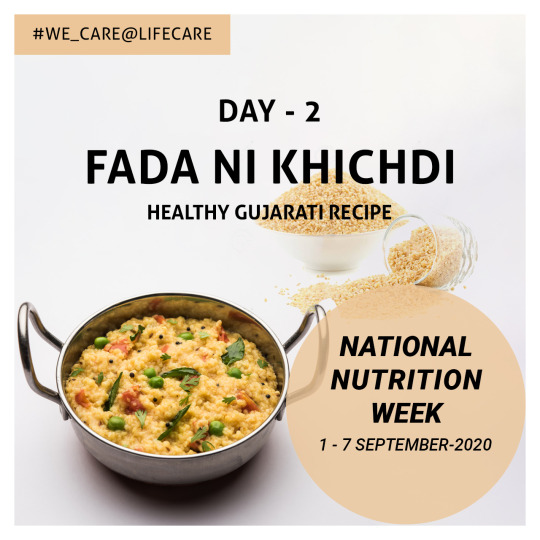
Life Care Hospital Celebrates Nutrition Week.
Name of Recipe- Fada ni Khichdi (Healthy Gujarati recipe)
Ingredients (with qty)-
1 cup Broken Wheat (Dalia/ Godumai Rava)
1/4 cup Yellow Moong Dal (Split)
1/2 teaspoon Turmeric powder (Haldi)
1/2 teaspoon Garam masala powder
1 tablespoon Ghee
1 Carrot finely chopped
1/4 cup Green beans (French Beans) , finely chopped
Salt to taste
1/2 teaspoon Whole Black Peppercorns , coarsely crushed
For Tempering
2 Cloves (Laung)
1 Cardamom (Elaichi) Pods/Seeds
1/2 inch Cinnamon Stick (Dalchini)
1 sprig Curry leaves
1/2 inch Ginger , grated
2 Green Chillies , slit
1/2 tablespoon Cumin seeds (Jeera)
1 Dry Red Chilli
1/4 teaspoon Asafoetida (hing)
Time to prepare- 25 mins
Steps in making-
1. To begin making Fada Ni Khichdi recipe, firstly soak the moong dal in warm water for 15 mins.
2. In a small pressure cooker, heat half of the ghee. After adding the ghee, add cloves, cardamom, cinnamon stick, curry leaves, ginger, green chillies, cumin seeds, dry red chilli, asafoetida, shahi jeera.
3. Once these begin to sizzle add in the lapsi.
4. Fry the lapsi in the ghee for 2 mins till a nice aroma comes out.
5. After 2 minutes, add the soaked and drained moong dal and fry for 1-2 mins.
6. Add the veggies- carrots, beans and saute again for 3-4 mins and add salt according to your taste.
7. Once it is done, add the turmeric powder and garam masala powder.
8. Now add 2-3 cups of water for a slightly runny khichdi or 2 cups of water for a grainy khichdi. Pressure cook it till the cooker releases 2-3 whistles. Let the pressure come down on its own.
9. Now add the black pepper and stir. Adjust salt and spices according to your taste and mix it properly.
10. Serve Fada Ni Khichdi along with Raita, Spicy Raw Mango Pickle, and papad by the side.
Nutritional value-
Calories 396 calories (per serving)
Energy- 396 cal
Protein- 15.4 g
Carbohydrates- 59.4 g
Fiber- 7.9 g
Fat- 10.8 g
Cholesterol- 0 mg
Sodium- 28 mg
Benefits of recipe- a simply, wholesome, flavourful creation made of fibre-rich bulgur wheat, veggies and moong daal, the fada ni khichdi is a wonderfully tasty way to keep cholesterol levels under check.
Those wishing to lower cholesterol or control their weight can switch from rice to broken wheat as it is rich in fibre.
When to eat- as healthy lunch.
So, with a hope that this food article was found helpful for our readers, we @life_care pray for your healthy life in this COVID situation with noticeable change in weather, take care of yourself and the people around you. With that note we @Life care are committed to provide healthy life to all our patients. Life care hospital is leading name in critical care treatment and cardiac emergency but also wants our patient to be absoulty fit, tackling all the odds of this pandemic. #wecare@lifecare.
0 notes
Text
Moong dal carrot salad | hesaru bele carrot kosambari recipe

Home dal recipes
moong dal carrot salad | hesaru bele carrot kosambari recipe
By
Hebbars Kitchen
-
February 20, 2019
moong dal carrot salad | hesaru bele carrot kosambari recipe with detailed step by step photo recipe. moong dal salad is the most healthiest and easiest salad along with carrot.moong dal carrot salad | hesaru bele carrot kosambari recipe with step by step photo recipe. this is a typical south indian salad served in every function of ours. i love to prepare salad as it is very simple, healthy and tasty dish. we south indians, eat this salad as it is or with hot steamed rice. however, i recommend you to try this for having in morning breakfast or a evening snacks. furthermore, this salad is so attractive, that you can pack to your kids lunch box as well.
kosambari is a delicious, protein rich lentil and good for weight reduction. it is also popularly called as moong dal salad, kosumalli or hesarubele kosambari. most of all, it is a must side dish of every festive meal or wedding feast. moreover, i learnt this salad recipe from my mother in law. she prepares almost all kind of healthy salads with variety of lentils. the crunchy bite of pomegranate makes the salad more juicy and tasty.

kosambari is easy and quick to make. firstly the moong dal is soaked in water and later mixed with grated cucumber, fresh coconut, raw mango, coriander leaves, pomegranate seeds, sprouts or any healthy veggies of your choice. furthermore, make sure to soak the moong dal atleast 10 minutes as it helps to easily digest. moreover, the tanginess is got by lemon juice. so always add salt and lemon juice just before serving. else the salad will turn watery.
finally, if you like kosambari, then you would certainly love my other side dish recipes. especially, palak paneer, stuffed brinjal, molake kaalu palya, aloo bhaji, suvarnagadde palya, sabbasige soppu palya, batani gasi.
recipe card of moong dal carrot salad | hesaru bele carrot kosambari:

moong dal carrot salad | hesaru bele carrot kosambari recipe
5 from 1 vote
PREP TIME:30 MINUTES
COOK TIME:5 MINUTES
TOTAL TIME:35 MINUTES
SERVINGS: -3 SERVINGS
AUTHOR:HEBBARS KITCHEN
COURSE:SALAD
CUISINE:SOUTH INDIAN
Print Recipe Pin Recipe
easy moong dal carrot salad | hesaru bele carrot kosambari recipe
INGREDIENTS
FOR SALAD
½ cup moong dal
1 carrot, grated
¼ cup coconut, gratted
few chopped coriander leaves, chopped
1 green chilli, chopped (optional)
2 tbsp pomegranate seeds / dalimbe
½ tbsp lime juice
salt to taste
FOR TEMPERING:
½ tsp mustard seeds
1 tsp urad dal
a pinch of asafoetida / hing
5-6 curry leaves
1 tsp oil
INSTRUCTIONS
firstly, soak moong dal for half an hour to one hour and drain off the excess water in a strainer.
furthermore, leave for some time so that all water fades away.
now keep aside grated half cup carrot, ¼th cup of coconut, 1 chilli and half lemon
in a mixing bowl add strained moong dal, grated coconut, chilli and grated carrot.
mix well together
furthermore, add coriander leaves.
moong dal carrot salad
just before serving, add salt and lemon juice and mix well.
furthermore, in a small pan heat oil and crackle mustard seeds and add urad dal and fry until it turns red. add curry leaves and asafoetida and fry for few more seconds. add the seasoning to the mixed salad and mix it nicely.
finally, garnish it with pomegranate and serve it with rice or you can eat plain.
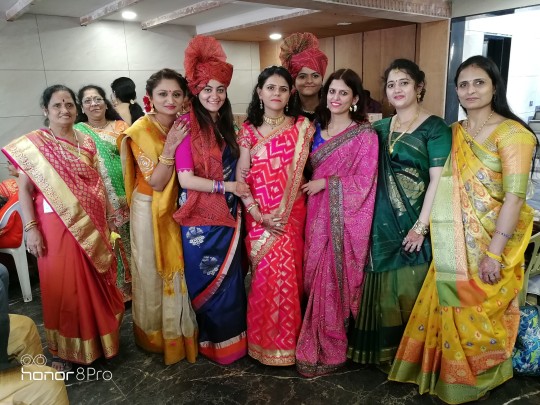
With Bhabhis...
0 notes
Photo

That Deadly Simple Yet Deadly Yummy Meal - Done We were craving a simple dal-rice-fried fish meal & since I had super fresh pomfret at home I decided to indulge & made this Clockwise : 1. That @thegutlessfoodie Signature Salad Cucumber Sticks & lime 2. That Foofoo Chilli Garlic Fish Fry I marinated sliced pomfret that I bought from @fishvishindia in a smooth paste that I made with garlic, cumin, dried red chillies, lime juice & salt I fried these in seasoned mustard oil till done 3. That Mango Pachadi I cut raw mango into cubes & added it into a pot along with chopped tomatoes, onions, enough water to cover, coriander powder, red chilli powder, dried fenugreek leaves /kasuri methi & salt. Covered & cooked for about 20 minutes or till the water reduced substantially. I added some jaggery to balance & once cooked down I mashed everything coarsely I tempered ghee with mustard seeds, cumin seeds, curry leaves, garlic, asafoetida & mixed into the simmering chutney 4. That Tangy Milijhuli Dal/Mixed Lentils I pressure cooked a mix of skinless split mungbeans & skinless split pink lentils /Masoor dal in salted water along with asafoetida & turmeric powder. I released the pressure after 5 whistles, churned & left to simmer along with fresh coriander & kokum/Garcinia Indica I tempered ghee with cumin seeds, green chillies, curry leaves, garlic, red chilli powder, cumin powder & poured it into the simmering lentils and simmered till it thickened. Mixed in rice just before serving I must give due credit - the masala for the fried fish was inspired by a neighbour in my building whom I don't know. I do know their neighbour @soniamarwah who gave me some to try. I knew immediately I'd use this for fish. I replicated it with my own little twist & I must say it turned out fantastic The mango chutney was almost identical to Asha @foodfashionparty 's mom's but I added a couple of ingredients to suit our palates. Adapt tried & tested recipes to your palate. That's the beauty of food. Don't you think? (at One North) https://www.instagram.com/p/CBnoKZgg-Tb/?igshid=44y8ek28v7r9
0 notes
Photo
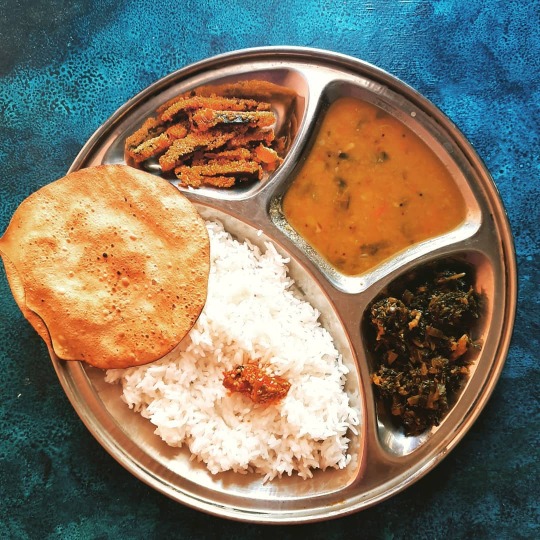
As the lockdown is extended it is time to continue cooking this delicious lunch. Today's #vegetarianmeal was simple #veganfood The #lockdown2 cannot stop me from cooking delicious food. #onmyplatetoday was ✔Rava fried bhendi ✔Dal fry ✔Methi subzi ✔Steamed rice ✔Roasted papad ✔Raw mango pickle What did you all have for lunch today? Follow @rakshaskitchen #rakshaskitchen for more yummy updates. (at Bangalore, India) https://www.instagram.com/p/B_Ce7x9FDiV/?igshid=1lwaamydls0gc
0 notes
Photo
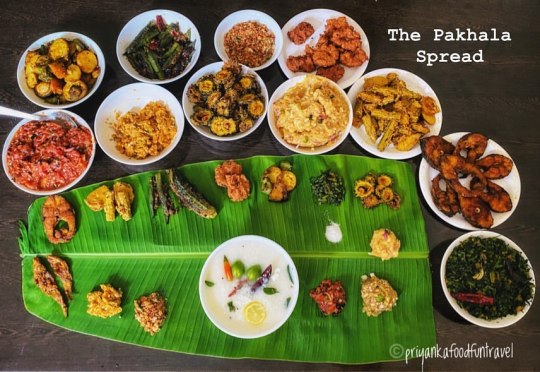
PAKHALA PASARA Pakhala is not only a dish but emotion for all Odias around the world. We Odias are very proud of our rich heritage and culture, we all know how food is an integral part of our culture. On 20th March, we celebrate World Pakhala Divas, a trend which was created few years back on twitter giving it the recognition it very much needed. Personally I love these food celebrating days, and this one in particular is very close to me as it celebrates the dish which not only I love to eat but have so much memories attached to it. It was my working day at office, we planned to cook up a feast and enjoy this day with my staff. Pakhala is a dish with so many variations, Saja Pakhala, Basi Pakhala, Chhunka Pakhala, Chain Pakhala and Dahi Pakhala to name a few. I made Dahi Chhunka Pakhala which is basically cooked rice soaked in water, tempered with Cumin, mustard seeds and fennel seed along with crushed ginger, chillies, curry leaves and raw baby mangoes (amba kasi) and added curd and slices of lemon on top. Mostly Pakhala is eaten with various side dishes called BHAJA-CHHANA, TARKARI , PODA-JALA and PAGAW-BHARTA-CHATUNI In Bhaja-Chhana, there was : Saga Bhaja: leutia greens fried with chopped pumpkin, tempered with garlic, puncha phutana and dried red chillies Pariba Cheki Bhaja: different veggies like pumpkin, ridge gourd, raw banana and potato diced in round shape and fried with crushed garlic and green chillies. Kalara Pithou Chhana: thinly sliced bitter gourd coated with rice batter and deep fried. Butto Dali Pakudi: deep fried dumplings of chana dal, with crushed cumin, ginger, green chillies, onion and curry leaves. Gota Kalara Bhaja: bitter gourd stuffed with crushed cumin, garlic, onion and red chillies , then slow fried on a tawa Gota Bhendi Bhaja: ladies ginger, stuffed with the above masala. Kakharu Phula Bhaja: Pumkin flowers coated with rice flour batter and tawa fried. Fish fry: plain Rohu fish fry in mustard oil In Tarkari Section, there were few things like: Sajana Chhuin Aloo Rai: this is a common dish eaten with pakhala, potato and drumsticks are first fried and then cooked in mustard paste Sukuwa Tatiyaa Basa: Patir (at RBD Stillwaters) https://www.instagram.com/p/B-WYFqyFpft/?igshid=s6fmbkjsm5wd
0 notes
Text
Mango Dal
Recipe from Komali Nunna
Ingredients
1 cup toor dal
4-6 cups water
1 green raw mango, peeled, and cut around the pit into 1-inch pieces
1 cup chopped onion
2-5 fresh green chiles, such as serrano, cut lengthwise in half
1/2 tsp turmeric
1 tsp salt or to taste
Seasoning
2 tbsp vegetable oil
2 dry whole red chiles, such as chile de arbol
1 tsp black mustard seeds
10-20 curry leaves
2 tbsp cumin seeds
Directions
Place dal with 3 cups of water in a large sauce pan. Bring it to a boil over medium high heat. Boil for 5 minutes. Reduce heat to medium and simmer for 15 minutes while stirring occasionally. As the dal is being cooked, you will notice some of the scum rises to the top; simply stir it back in. Add mango, onion, green chiles, turmeric and salt and continue to cook. Add more water as needed. Cook for about 25-30 minutes until dal is creamy and the mango pieces are soft but still intact.
To season, heat oil in a small skillet over medium high heat. Add red chiles. When red chiles turn one shade darker, add mustard seeds and cover with the lid until spluttering subsides. Uncover and add cumin seeds. Once they sizzle, add curry leaves. As soon as the curry leaves are crisp, add onions. Fry until onion turns golden brown. Add the seasoning to the cooked dal and stir in. Remove green and red chiles. Season to taste and serve with rice or chappati.
Serves 4-6
1 note
·
View note
Text
LUNCH IDEA
MENU # 13
This lunch menu has chayote (chow chow) & murungai(drumstick) sambar with Amaranth Keerai masiyal , Beans paruppu Usli, spiced raw mangoes with yogurt and Jangri/Imarti for dessert.
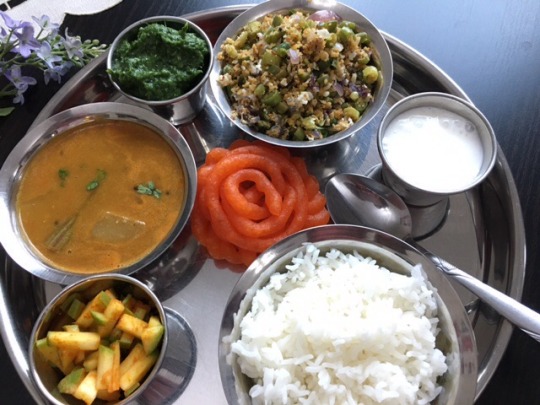
TO PREPARE PARUPPU USLI – wash and soak 1/2 cup of chana dal for almost 2 hours. Then strain the water and grind it with 2 to 3 red chillies, 1/4 teaspoon jeera and few peppercorns and 1/4 teaspoon hing to a coarse paste and then add salt , mix well and steam boil the dal mixture for 8 to 10 minutes. Allow it cool and again pulse it in the grinder to have a grainy powder consistency.
Soaked chana dal with spices
Steam boiled dal mixture and beans…ready for tadka
Beans paruppu Usli
Finely chop the beans and steam boil it by adding a pinch of salt and sprinkle some water. Once boiled, Drain out the water and keep aside.Finely chop the onion and two cloves of garlic (optional ) and some curry leaves.
Heat a thick bottomed pan or kadai and add two table spoon of extra vigil coconut oil or olive oil or any other vegetable oil. Add mustard seeds and allow it to splutter and then add a pinch of jeera, garlic, onion and curry leaves and fry until onions became translucent. Now add the dal and give it a fine stir. After 2 to 3 minutes add the steam boiled beans and adjust salt. After 2 minutes add freshly grated coconut and switch off the flame immediately.
Paruppu Usli can be prepared with vegetables like Beetroot,cluster beans, Vazhai poo/ Banana flower, Methi / fenugreek leaves or combine one or two vegetables like carrot and beans, carrot and beetroot etc.
Beetroot Usli
Beans paruppu Usli
Lunch idea-Rice with beans paruppu Usli LUNCH IDEA MENU # 13 This lunch menu has chayote (chow chow) & murungai(drumstick) sambar with Amaranth Keerai masiyal , Beans paruppu Usli, spiced raw mangoes with yogurt and Jangri/Imarti for dessert.
0 notes
Photo
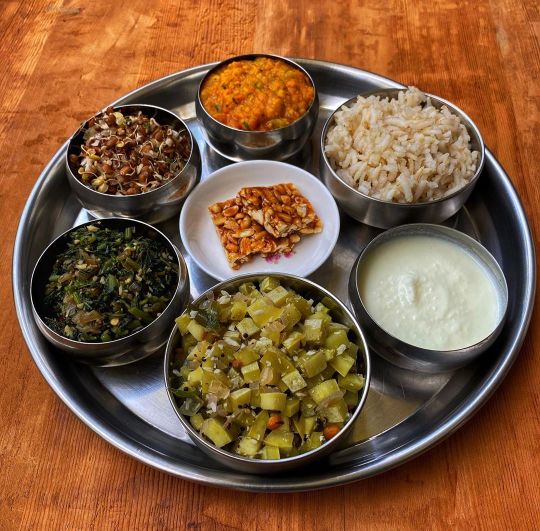
🍀Lunch Today🍀 🐍 Pudalangai Poriyal - Snake Gourd Stir-Fry 🍃 Keerai Poriyal with lots of fresh shredded coconut - Green Amaranthus Stir-Fry 🥗Mulai kattiya Kollu Sundal - Sprouted Horsegram Fry 🍲 Mammidikaya Pappu - Raw Mango Dal / Lentil mash 🍚 Brown Rice 🥛 Thayir - Curd 🥜 Kadalai Mittai - Peanut Brittle for dessert https://www.instagram.com/p/CETjPCHpLpd/?igshid=9uwqscls0qrv
0 notes
Video
youtube
Recipe: Mango Dal / Mambala Paruppu Kulambu – Mango Recipes
Text Recipe - https://madraasi.com/2017/05/21/mangodal-mambalaparuppu-mangorecipe/
Mango Dal was little sweet, tangy and spicy, which went goes out well with pulav’s, rice, roti or Indian flat bread. I have prepared it using both ripe and raw mangoes for the perfect taste, I had there. We all like it and accompanied it with pulav, potato fry and appalam / pappad.
#madraasi#immadraasi#recipe#recipes#food#foodie#food blog#food blogger#food blogging#indian food blog#indian food blogger#indian cuisine#tamil cuisine#mango dal recipe#mango dal tadka#mango recipe#mango recipes#mango dal curry#side dish for chapathi#side dish for Indian flat breads#follow#followme#likes#mambala paruppu kulambu#mambalam recipe#Indian summer#tamil summer#tamil summer recipes#foodstagram#south Indian food blog
0 notes